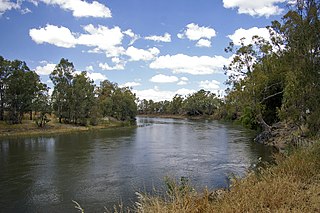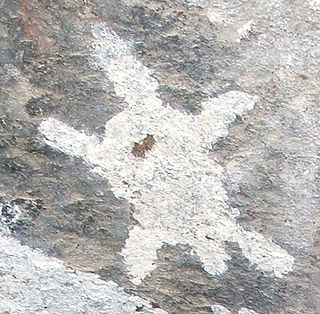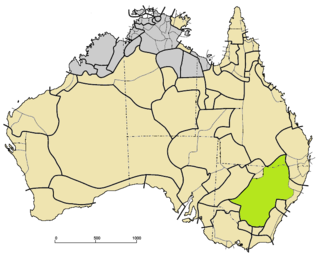Country
According to Norman Tindale, the Walgalu's traditional lands consisted of some 2,600 square miles (6,700 km2) of territory centering around the headwaters of the Murrumbidgee and Tumut rivers. Kiandra was located within their boundaries, whose southern extension ran down Tintaldra, and whose northeastern limits came close to Queanbeyan. Josephine Flood argued, on the basis of a note in A. W. Howitt, that they were attested as far south as the upper Murray site of Kauwambal between Mount Kosciuszko and Mount Cobberas, which would place their summer camping somewhat west of the Djilamatang.

Norman Barnett Tindale AO was an Australian anthropologist, archaeologist, entomologist and ethnologist.

Murrumbidgee River, a major tributary of the Murray River within the Murray–Darling basin and the second longest river in Australia. It flows through the Australian state of New South Wales and the Australian Capital Territory. It descends 1,500 metres (4,900 ft) as it flows 1,485 kilometres (923 mi) in a west-northwesterly direction from the foot of Peppercorn Hill in the Fiery Range of the Snowy Mountains towards its confluence with the Murray River near Boundary Bend.

The Tumut River, a perennial stream that is part of the Murrumbidgee catchment within the Murray–Darling basin, is located in the Snowy Mountains and South West Slopes districts of New South Wales, Australia.
According to Steven Avery, culture group boundaries in southeastern Australia are disputed, due in part to the inexactitude of linguistically assigned boundaries and the uncertainty of historical records.
The Cooma local government website, based on recent research, differentiates between two Aboriginal groups which resided in their region, stating that "the two main groups on Monaro were the Ngarigo people of the tablelands and the Wogul or Wolgalu group in the high country."

Cooma is a town in the south of New South Wales, Australia. It is located 114 kilometres (71 mi) south of the national capital, Canberra, via the Monaro Highway. It is also on the Snowy Mountains Highway, connecting Bega with the Riverina.

Monaro, once frequently spelled "Manaro", or in early years of settlement "Maneroo" is a region in the south of New South Wales, Australia. A small area of Victoria near Snowy River National Park is geographically part of the Monaro. While the Australian Capital Territory is not considered part of the region, some towns in the Monaro have close links with Canberra.
This page is based on this
Wikipedia article Text is available under the
CC BY-SA 4.0 license; additional terms may apply.
Images, videos and audio are available under their respective licenses.

The Ngunawal are an indigenous Australian people of southern New South Wales.
The Kurrama people are an indigenous Australian people from the Pilbara region of Western Australia.

The Thaua/Thawa, also spelt and also called Yuin-Djuin, were an Indigenous Australian tribe living around the Twofold Bay area of the South Coast of New South Wales.
Ngambri is an Aboriginal name for a locality in the south-east of Australia, near the centre of what is now Australia's capital city of Canberra. The area is close to Black Mountain along Sullivans Creek down to the Yeelamgigee, now Molonglo River. The extent of recognised Ngambri territory, and of their distinction from the Walgalu, has been the subject of controversy in recent years. Canberra, where Ngambri claims are made, lay close to the tribal boundaries that separated the Ngarigo from the Ngunawal.
The Wandandian were an indigenous Australian people of the South Coast of New South Wales with connections to the Yuin and Tharawal nations.
The Ngaiawang were an indigenous Australian people of South Australia. They are now considered extinct.
The Djilamatang were thought to be a distinct Indigenous Australian people of the state of Victoria, Australia. This has recently been questioned by Ian Clark.
The Jaitmatang, also spelled Yaithmathang, were an indigenous Australian people of the State of Victoria.
The Mariamo or Marri ammu are an indigenous Australian people of the Northern Territory.
The Ngadjunmaia are an indigenous Australian people of Western Australia.
The Awarai (Warray) are an indigenous Australian people of the Northern Territory.
The Djiringanj are an indigenous Australian people of the southern coast of New South Wales.
The Wirngir are an indigenous Australian people of the Kimberley region of Western Australia.
The Yeidji, otherwise commonly known as the Gwini, are an indigenous Australian people of the Kimberley area of Western Australia.
The Wilawila are an indigenous Australian tribe of the Kimberley region of Western Australia.
The Ngolibardu, otherwise written, Ngulipartu, were an indigenous Australian people of Western Australia.
The Baiyungu are an indigenous Australian people of Western Australia.
The Mandjindja or Mantjintjarra are an indigenous Australian people of Western Australia.
The Kalaako (Kalarko) were an indigenous Australian people of the Goldfields-Esperance region of Western Australia.








